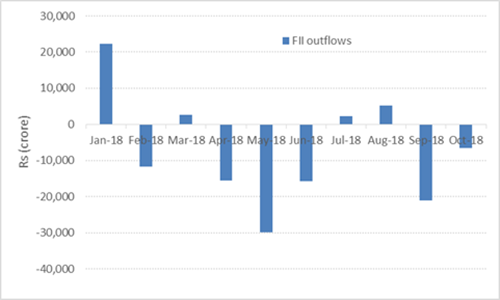At 68-69 against the U.S. Dollar, the Indian Rupee looked strong to some experts a few months ago.
No! It’s too overvalued, others had announced.
73.81 is the latest low.
[Read: Should You Invest In International Funds To Benefit From Weak Rupee?]
More bure din to come?
Making new lows has become a trend for Indian Rupee nowadays.
It has depreciated over 16% since the beginning of 2018.
Falling Rupee is not only worrying the government and RBI, but it’s now started denting the wallet of the common man.
 (Image source: pixabay.com)
(Image source: pixabay.com)
And, the political blame game has come full circle.
About five years ago, India was in a similar situation.
The statements of the prime ministerial candidate of BJP at that time have come back to haunt his government today. In August 2013, Mr Narendra Modi blamed the UPA government for its lack of concern towards the falling Rupee. “The country is disappointed today because the government is neither concerned about the economy nor the falling rupee. It is only worried about saving its chair.”
Is this applicable to any ruling party of the day in India?
This time you will hear similar comments from the present opposition.
Well, if you want to participate in political debates and blame games, you most definitely can, but will that yield any substantial result?
Alternatively, if you can focus on the latest happenings and try to assess their impact on your portfolio, isn’t it a wiser option?
Get to know the reality behind the falling Rupee.
First and foremost, let’s understand that the falling rupee isn’t always bad news. So anytime you hear somebody condemning the falling Rupee, don’t conclude that it’s bad for India unless you know the reason.
Try to find out reasons why it’s falling.
Do you know what does the falling Rupee donate?
It simply suggests that the demand for US Dollars (in India) is higher than its supply, i.e. inflows of US Dollars.
At present, the demand for US Dollar is too high as compared to its supply. Why is this so?
-
Imports are costing India more and exports aren’t keeping up the pace
-
Foreign investors are dumping Indian securities
-
And there’s a sentimental impact as well
Rising crude oil prices and falling rupee
The falling Rupee boosts exports but makes imports expensive. And as you must be aware, crude oil is the largest constituent of India’s import basket.
And right now crude oil prices are burgeoning in the international market.
Therefore, the present fall is definitely a cause of concern for India.
But do you know, India is a prominent exporter of refined oil? In fact, refined oil is the second largest constituent of India’s export basket.
In other words, if India is losing foreign exchange due to a massive rise in the crude oil prices, it's being partially offset by the higher exports, in value terms, by the refiners.
That said, rising crude oil prices can cause inflation in India.
Higher inflation has many other implications such as the falling demand and rising interest rates among others. In other words, it affects the country’s overall investment climate.
Therefore, the combination of falling Rupee and rising crude oil prices can prove detrimental for India.
Other imports are rising and exports aren’t keeping pace
At 9.8% Indian exports have grown at the fastest rate in FY 2017-18 in comparison to the preceding six years.
The only downside is that exports are falling short to compensate for the rise in the import bill. As a result, India’s Current Account Deficit (CAD) is rising faster. The reading of 2.4% for the April-June quarter looks alarming. Lately, imports of electronics have been the cause of concern. Not only it’s affecting the ‘Make in India’ prospects, but it is also costing India its valuable foreign exchange reserves. Should exports fail to rise hereon, India’s CAD position will worsen further.
Foreign Institutional Investors (FIIs) have been selling relentlessly
Investors have started losing patience as there hasn’t been any recovery in the Rupee. As the Rupee scaled to 74 against the US Dollar yesterday, bulls on the Dalal Street completely surrendered to bears. Nearly 1,900 stocks ended the day in red, while only 753 managed to stay in the green. About 290 stocks hit their lower circuit. When a stock hits its lower circuit, the trading halts temporarily because there aren’t buyers. And this impacts mutual fund returns, pulling down the returns.
Graph: FIIs ditching India

Data as on October 04, 2018
(Source: CDSL)
So far this year, Foreign Portfolio Investors (FPIs) have withdrawn Rs 68,100 crore from Indian capital markets. Out of this, the share of equity outflows is around 27%. Rising Dollar value makes it less attractive for FIIs to invest in India.
Will FIIs come back soon?
Unlikely!
Unless FIIs believe that the Indian markets have fallen to a level where valuations look attractive or the Indian Rupee is done with its fall, it’s unlikely to see them return to Indian markets.
Isn’t it ironic that FIIs aren’t enthused to invest in the fastest growing economy in the world? This is the sentimental impact.
In their view, the problems of the Indian economy aren’t over just yet.
The sentimental impact on the Rupee is also a result of what happens to other emerging market currencies. The rising Dollar is a global phenomenon which is causing a drain of Dollars from emerging markets and is resulting in an incredible inflow of capital back to the U.S. economy. On-going trade war issues and geopolitical tensions are adding fuel to the blaze.
Some relief:
-
India has a huge war chest of around US Dollar 400 billion which gives it an edge over other emerging market economies in defending the value of its currency.
-
Moreover, RBI has been taking some smart steps to lower the dollar demand. It’s recently allowed oil and gas sector companies to raise working capital through External Commercial Borrowings (ECBs). This shows RBI is walking a tightrope on the growth-inflation dynamics.
-
RBI hasn’t yet utilised the option of raising Foreign Currency Non-Repatriable (FCNR) deposits. Which means India has enough ammunition to counter the falling Rupee.
-
The government has made it clear in the past that if other emerging market currencies are accompanying the Indian Rupee in its free fall, it’s not going to intervene aggressively.
Impact on your investments
Needless to say, falling Rupee is bad for your investment portfolio, by and large. Your investments in mutual funds are and will be affected due to the depreciating currency. Lately, the government lowered the retail fuel prices, perhaps, keeping in mind the forthcoming assembly elections.
Lok Sabha elections aren’t far either. Such populist measures often result in the rising fiscal deficit which affects the currency even worse. Hardening bond yields suggest that the debt mutual funds might remain under pressure even in the future.
Since the rapidly changing macroeconomic scenario is affecting the revenue and profitability of Indian companies, the impact on equity and equity mutual funds is negative. A few companies having a high export market might benefit by falling Rupee.
If you have invested in a worthy mutual fund scheme, the fund manager might have assessed such opportunities and might have invested in them as well.
This is why, we, at PersonalFN, always believe, selection of a mutual fund is an extremely crucial decision.
You should invest in a mutual fund scheme that has a proven track record across timeframes and market phases. It is best to consider such funds only if they come from a process-driven fund house. Those relying excessively on the fund managers eventually fall behind when their star fund managers leave the fund house.
Watch this video to learn how to select winning mutual funds:
And long-term mutual fund investors shouldn’t panic because of current market volatility.
Investing in mutual funds through Systematic Investment Plans (SIPs) is the best strategy to tackle volatile market conditions such as the ones witnessed currently.
And don’t forget to invest in mutual funds as per your personalised asset allocation that takes into account your financial goals and the risk appetite.
[Read: Why You Should Not Ignore Personalized Asset Allocation While Investing]
[Also read: Are You Ready With Your Financial Goal Worksheet?]
At present, you should not refrain from investing in equities or discontinue your SIPs, particularly if you have long-term financial goals to accomplish. It would prove to be an unintelligent decision.
Editor’s Note:
Want to build a SOLID mutual fund portfolio based on your risk profile and investment time horizon?
But don’t have time and skills to select worthy mutual fund schemes?
Connect with us. PersonalFN has the expertise to create a winning portfolio.
PersonalFN’s flagship mutual fund research service FundSelect Plus is the answer!
You get access to PersonalFN’s 7 High-Performing, Time-Tested Readymade Portfolios offered under FundSelect Plus. These portfolios are backed by decade-long market-beating track record.
Happy Investing!
Add Comments